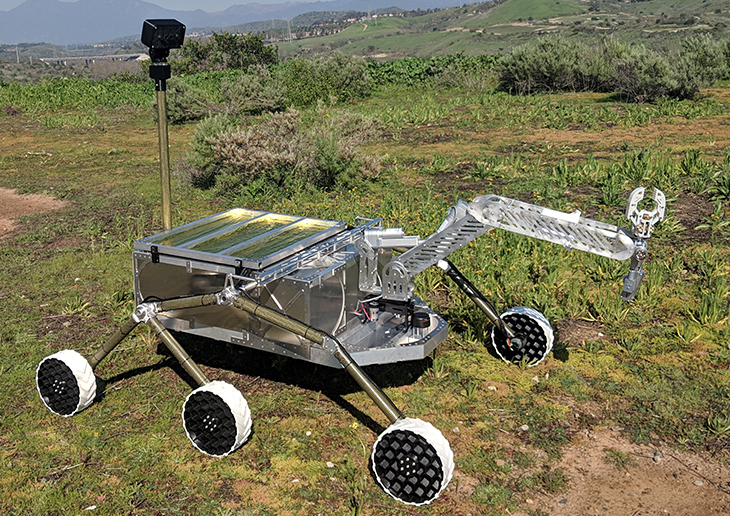Rover Achievers: Team Saddleback Competes Alongside Harvard, Yale, Berkeley College News
June 27, 2019

The University Rover Challenge in Utah brings together the boldest and brightest from all over the world. This year, 84 teams from 13 countries, including the United States, Colombia, Egypt, Germany, India, Poland, and Turkey, competed to see who could build the best Mars rover. Saddleback was the only community college in the world to compete, with more than 20 members spending countless hours to bring their rover, Aurora, to life.
“From the front to the back wheel, the rover is six feet,” project lead and Saddleback student Cory Hague relates. “It was one of the largest ones in the competition, if not the largest.”
Hague is a second-year physics student with dreams of going into aerospace to work on robotic colonization systems. Last year, he had a passion for building a rover, and when he found the University Rover Challenge, he knew he had to take the plunge.
“I proposed it to the physics chair, and it grew from there,” Hague says. “We got all the faculty and staff support, and everyone was so excited to join the team. We had more people who wanted to join than we could have!”
Saddleback was a brave underdog, competing with first-class teams from more experienced engineering and tech universities with access to graduate students and resources. According to Hague, “many of these teams have competed for several years, so they already have established designs, facilities, financial backing, and logistics. We had to start everything from the ground up using only the experience of freshman and sophomore students.” Competitors included teams from vaunted universities like UC Berkeley, Cornell, Harvard, Stanford, UC San Diego, and Yale.
But the Saddleback team rose to the occasion with determination and gumption. According to the team leader, the college and faculty were overwhelmingly supportive and were able to help the team get exactly what they needed. Meanwhile, the students worked tirelessly to obtain funding, putting in many hours of work and networking.
“Our school has never done a challenge like this,” says Hague. “We had to really sit down for months and think through the pros and cons of each system and design from the ground up with students who have limited experience. It was a lot of work. For the first four months, we had no idea where to get funding or parts.”
Hague’s part-time job at Applied Medical Resources connected the team with its first source of funding when the company donated $1,000 toward the project. After that, it was a miracle of support and generosity, with student government, faculty, and staff working to pull together contributions and solicit donations. All told, the Saddleback team raised more than $18,000, with donors including Saddleback ASG, Saddleback IDSC, Zimbalist Arts LLC, Irvine ElectroOptics LLC, the Philip and Elizabeth Hiestand Summer Science Research Fund, and Versa Robotics LLC.
“We were very fortunate to have the full support of nearly a dozen faculty and staff throughout the year,” Hague says. “I was truly amazed to see how much our faculty and staff cared for the success of our students and how much personal time they committed to seeing us succeed and learn.”
Max Rivera, the business team lead, echoes Hague’s sentiments.
“None of this would be possible without the hard work and dedication of our team and the support of our faculty and sponsors,” says Rivera. “SC robotics is capable and ready to show the world scientific rigor and academic excellence start at the community level. To inspire greatness tomorrow, we must aspire to the cosmos today.”
The event combined STEM, CTE, and Engineering students into a multi-disciplined team. Hauge explains, “We were really just an independent team of students who were dedicated to competing. Many of the students ended up joining the team by word of mouth or by overhearing our design meetings that were held in the school library at the beginning of the school year.”
Students split up the work across five teams: mechanical, science, programming, electrical, and business. The mechanical, electrical, and programming teams were responsible for designing and building the rover. The science team ran all of the experiments onboard the rover, which focused on detecting present, extinct, and extant life, and throughout the year conducted dozens of assays to evaluate the science for the rover. Meanwhile, the business team created the website, logo, and video. Not only did students develop professional, technical, and interpersonal skills to bolster their resumes, but they also had tremendous fun doing it.
Beyond the logistics of funding and organization, Team Saddleback also faced complex technical challenges. According to mechanical team lead Margarette Strong, the Saddleback rover featured “a traditional rocker-bogie suspension system with the geometry that is optimized for the implementation of modular subsystems such as the science of apparatus.” If that sounds like rocket science, well…it pretty much is.
“We also make use of lightweight composites in order to maximize our payload capacity,” explains Strong. “In order to improve performance and time efficiency during the competition tasks, we have incorporated both the Phillips and socket head onto our end effectors, allowing us to easily select the appropriate tool while conducting the mission.”
The University Rover Challenge was highly selective, with only 36 out of 95 teams gaining acceptance. The Saddleback team got very close and made it through the preliminary design review milestone, but fell just short of the second phase.
Hague and his team were not discouraged in the least.
“We did produce a very capable system, and we are extremely proud of everything that we achieved,” he says. “During the competition, we were commended by many seasoned teams about how exceptionally impressive our rover was, especially as a first-year team.”
Hague attended the full competition, along with his science team lead, in hopes of building knowledge and experience for next year’s effort. The experience, he says, taught him not to be intimidated by the competition, but rather to rise to the level of top university teams.
“Before we got to Utah, it seemed really competitive, but as soon as we went there and saw the teams, we saw that they were the most genuine professional family,” Hague says. “They told us all about their rovers and wanted to help us out and share ideas.
In fact, Team Saddleback is already gearing up for next year’s competition.
“It was way more than a competition,” says Hague. “After just seeing how amazing it was, I don’t want to miss out on next year!”
Hear more about Team Saddleback’s incredible story and watch the Saddleback rover in action at https://www.youtube.com/watch?time_continue=23&v=28o8UdUiPio.




